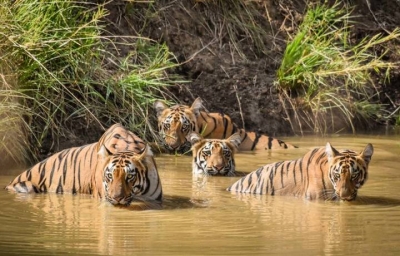
Located in Maharashtra’s Chandrapur district, Tadoba-Andhari Tiger Reserve comprises Tadoba National Park and Andhari Wildlife Sanctuary. Maharashtra’s oldest national park, Tadoba was created in 1955. Covering more than 600 sq.km., the area’s topography supports diverse habitats, including open canopy grasslands, stony grasslands along small hillocks, semi-deciduous riparian forest, perennial and seasonal streams, wetlands, and agricultural lands. All these make the region ideal for several species of birds, animals and reptiles to call it their home. A study conducted a few years ago recorded the presence of over 250 species of birds, including five endemic to India and more than 15 categorised as “threatened” in the International Union for Conservation of Nature’s Red List. The region also supports more than 70 species of butterflies.
Wildlife
Pochards, shovelers, teals, pintails, quails, francolins, grebes, pigeons, doves, nightjars, sandgrouses, swifts, cuckoos, malkohas, storks, herons, egrets, bitterns, cormorants, ibises, darters, stilts, lapwings, jacanas, terns, sandpipers, pratincoles, kites, eagles, harriers, vultures, buzzards, buttonquails, owls, owlets, hornbills, woodpeckers, barbets, parakeets, orioles, drongoes, fantails, shrikes, flowerpeckers, munias, swallows, martins, bulbuls, warblers, babblers, starlings, mynas and flycatchers are among the bird species found in the region. In addition to the keystone species, the Bengal tiger, the area is a habitat for mammals such as leopard, Indian wild dog, sloth bear, gaur, the Indian fox, rusty spotted cat, honey badger, small Indian civet and ungulates such as sambar, spotted deer, barking deer, nilgai and four-horned antelope. Reptiles from the area include marsh crocodiles, Indian python, common Indian monitor, terrapins, Indian star tortoise, Indian cobra and Russel’s viper.
Good news, but…
In 2019, a report released by the Parliamentary Standing Committee on Science and Technology, Environment and forests said that Tadoba witnessed two-fold increase – from 86,557 to 1.73 lakh – in tourist numbers between 2012-13 and 2017-18. This also meant an increase in revenue – Rs. 6.78 crore from Rs. 1.75 crore, a whopping 280 % increase. Such revenues are crucial for the upkeep of the region. Another comforting factor is that the Reserve was one of the few in the country that saw an increase in tiger numbers a few years ago. This too has been encouraging news for tourism since increased tiger numbers could translate to increased sighting, and in turn, more tourists. However, increase in tourists may not always be good news. Here’s why.
Only a few months ago did the government propose to offer ecotourism in the Reserve’s buffer zone to boost local economy. Since the zone includes more than 75 villages, the step aims to rope them in for conservation activities and sensitise them to human-animal conflict. With their knowledge of the region, the villagers could become drivers, guides, etc. While this is certainly encouraging, it is not without concerns. Among the activities planned for ecotourism include those such as adventure sports. Since such activities require experts, villagers and activists are worried that gradually private players could take over the region, leaving behind locals to suffer, defeating the very purpose it hoped to achieve.
Picture Credit : Google



